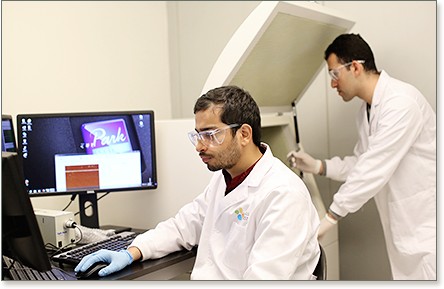
About Laboratory For Carbon Nanostructures
 The use of Carbon materials by Mankind can be traced back to pre-historical times. For millennia, charcoal has been employed to cook our food, to heat our houses and to draw testimonies of our daily life activities. Industrially, iron refining has been performed since the 19th century using large carbon rods as electrodes. Presently, Carbon-based materials have permeated our lives almost unbeknownst to most people in the form of fuselage panels for airplanes, inks for newspapers, tobacco filters, sport goods reinforcements, membrane switches for keyboards, etc.
The use of Carbon materials by Mankind can be traced back to pre-historical times. For millennia, charcoal has been employed to cook our food, to heat our houses and to draw testimonies of our daily life activities. Industrially, iron refining has been performed since the 19th century using large carbon rods as electrodes. Presently, Carbon-based materials have permeated our lives almost unbeknownst to most people in the form of fuselage panels for airplanes, inks for newspapers, tobacco filters, sport goods reinforcements, membrane switches for keyboards, etc.
While Carbon Science is commonly seen as a mature research field, the developments of the last three decades have significantly shaken consensual views of its limits, in particular as regards the technological potential of its varied allotropic forms. With the advent of improved characterization tools and novel synthesis approaches, it was possible to break through the barrier of the 100 nm to make and see particles smaller than ever before. As a result, the sub-field of Carbon Nanomaterials (or Nanocarbons) rose to prominence following the successive discoveries of the C60 molecule, carbon nanotubes, and graphene.
The Laboratory for Carbon Nanostructures (LCN) investigates a diverse range of topics related to Carbon-based materials. From vertically-aligned nanotubes to wafer-sized graphene films, the LCN activities on production rely heavily on two complementary chemical vapor deposition reactors (hot- and cold-wall). In addition to pure Carbon nanostructures, lattice doping is available through the concurrent use of gasses such as ammonia. Beyond this, the LCN customizes the structure and composition of its Carbon-based materials in varied ways, carrying out from simple high-temperature structural annealing to hybridization via conformal coating with atomically-thin layers of metals or oxides. Graphitization and elemental sublimation under vacuum, inert or reductive atmospheres represent additional processes available in-house. Wet chemistry equipment and labware are part of the tools used daily at LCN to modify the Carbon lattice through the addition of functional groups or to exfoliate and oxidize graphite flakes. While growth and processing constitute foundational steps, characterization of Carbon materials also figures heavily in our portfolio of research activities. In particular, how these nanoscaled structures respond to external stimuli at different length scales is a topic that we pursue with unreserved attention. Altogether, the LCN aims to use its expertise to tailor Carbon-based materials for applications that span from membranes for residual water decontamination to substrates for improved catalytic reactions. To this end, we collaborate with a number of groups in KAUST and abroad.
Currently, the LCN is composed of 9 members, 3 of these Ph.D. holders. Its Principal Investigator is Dr. Pedro M. F. J. Costa, Assistant Professor at the Materials Science and Engineering Program at KAUST and Adjunct Assistant Professor at the University of Aveiro, Portugal.
If you are interested in working with us, as a collaborator or by integrating our group, drop us a line or simply pop in. We are always on the lookout for dynamical counterparts that can strengthen our efforts and even taken us through paths that we may not yet have explored.

"KAUST shall be a beacon for peace, hope and reconciliation, and shall serve the people of the Kingdom and the world."
King Abdullah bin Abdulaziz Al Saud, 1924 – 2015
Thuwal 23955-6900, Kingdom of Saudi Arabia
Building 3 (Ibn Sina)
© King Abdullah University of Science and Technology. All rights reserved